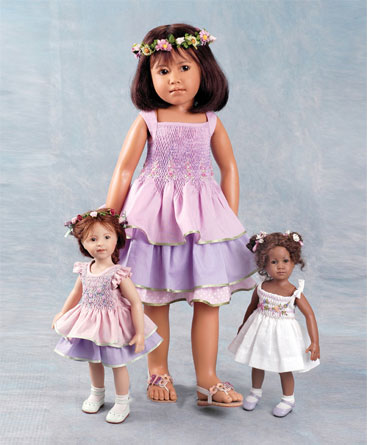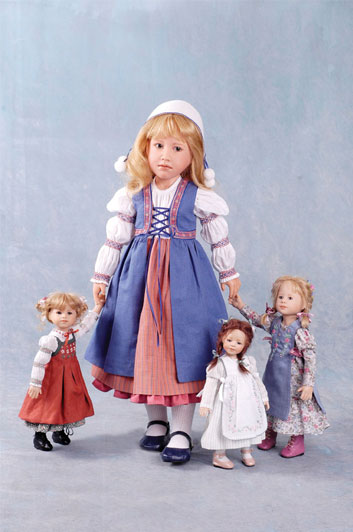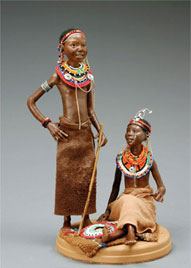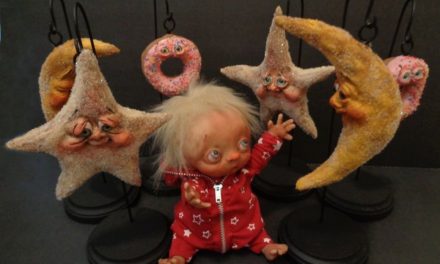One heartfelt request. That’s all it took for Heidi Plusczok to embark on a craft that would lead her to becoming a revered and award-winning doll artist. Almost 30 years ago, when her then 10-year-old daughter, Katja, asked for a porcelain doll, the die was cast, introducing Plusczok into the wonderful world of dollmaking—a career that has served her well.
Unable to afford such a doll at the time, Plusczok sculpted one out of Cernit. “I had no idea how to start a project like that, but I just took the doll I had as a child and used her as my model,” says Plusczok, 62, who resides in Germany. “I sat her in front of me and started to sculpt. … Her name was ‘Johanna,’ and I believe she turned out al right because it was a wonderful birthday present for my daughter.
“She was so happy and proud—of course, now her friend wanted a doll, too, and her friend’s friend. This is how I got my first orders and started my very first little production.”
Home of Fairytales
Plusczok grew up in Hanau, Germany—the city the Brothers Grimm called home. So it’s not surprising that creating dolls and fairytale characters has become such an intricate part of Plusczok’s life.
After creating that first doll, Plusczok gained the confidence to go forward. “I started out sculpting dolls for friends,” she says. “Later, I learned to work with porcelain and had my own workshops on making reproductions of antique dolls.
“My first porcelain dolls looked like antiques, but I then had the confidence to sculpt children’s portrait [dolls] and slowly found my own style.” Today, that style is reflected in her vinyl dolls, with their playful visages and happy demeanors.
The 1980s was a decade of learning, refining and teaching others to sculpt (through workshops as well as a book on sculpting technique). “I basically taught myself,” she says.
“Finding out how to work with porcelain … was quite difficult at that time,” she says. “There were no books available, and few artists who worked with porcelain. This kind of doll art was just emerging.”
But rather than feeling that learning a new craft was tedious, Plusczok was energized and dedicated. “I had to develop my skills and learned to do without dolls as models. … Now it got really exciting,” she admits. “The first portrait dolls of real children were created, and after that, I had many, many orders.”
Crossing the Pond
Already successful in Germany, Plusczok’s big break into the doll industry came in 1990 when she attended her first American International Toy Fair in New York. “I was very afraid to go to the States, but I did it anyway. The most incredible thing about this trip was that I was so successful I had orders for a whole year’s production and was thrilled,” Plusczok recalls.
Shortly after, Plusczok met the owner of German doll company Zapf Creation; they teamed up, with Plusczok creating models for the vinyl dolls Zapf would produce. “After the first collection (1995), it got harder and harder for me to see that others designed my clothing and painted my dolls,” she says. “I always had the urge to reconquer my dolls.”
A renegotiated contract with Zapf allowed her to do just that, selling her own vinyl dolls in the United States. “From then on, the dollmaking began all over again, and I was able to finally present my own vinyl collection in 1999, having the feeling that I had my dolls back,” she says. “It was very important for me that I took this step.”
For Plusczok, creating her vinyl dolls is a very personal experience—one she feels requires talent, creativity and endurance. She constantly refines her skills and her dolls. “When I finally complete a new collection, I feel very happy for a couple of days,” she says. “Then I start to make out details that are not perfect, and I know what I have to improve the next time. I never have the feeling that everything is perfect; there is always a little doubt that encourages me to change one thing or the other for the next collection.”
 Refueling, Looking Forward
Refueling, Looking Forward
With her 2009 collection underway, Plusczok has a busy schedule, but she finds solace and “regeneration” in her garden. “The garden is a place of rest for my family, my staff and myself,” she says. “I love to rearrange it—lots of colorful flowers, hidden little sculptures, a small fountain and shady hideouts help me forget the stress in the office and the shop. A little sunshine and birds singing are good to [help me] relax.”
Also fueling her passion for her dolls is the feedback Plusczok receives from collectors and dealers. “‘What am I going to do next year?’ shoots through my mind” she says. “My challenge is to be better each year.”
Joining Cultures, Breaking Borders
Through her dollmaking, Plusczok is focused on embracing and presenting the diversity of many cultures. Her 2008 line did that through the butterflies theme. According to Plusczok, some cultures believe butterflies are souls that come to life during a special time of the year with new beginnings. Her dolls epitomized the bright happiness and playfulness of butterflies.
The theme for her 2009 dolls is Merry-Go-Round. The children’s game has been around for more than 150 years—all around the world. It connects past and present as well as children of all cultures. Plusczok’s 2009 line will include 22 dolls—including several more than 70 cm.
According to Plusczok, “This game has united children since the 19th century, and it is still played today—both on Sundays in fine clothing after church and on schoolyards all around the world.”
This theme allows Plusczok to further explore her love of depicting children from all cultures. “More and more it has become an urge for me to join children from different cultures, unprejudiced in play, in my lines.
“For years, I had ideas for new faces when I saw the children on their way to the elementary school across the road from our house,” she says. “Since I started traveling to Indonesia, I was inspired by children of other parts of the globe.” She has since sculpted, among others, dolls with Balinese, Asian, Egyptian and African faces.
And while Plusczok is dedicated to getting the dolls’ looks “just right,” dealers seem thrilled with her execution. “Just as we were captivated by the pure souls of Heidi’s dolls—no one captures that expression of innocence better—time and time again, customers mention the same thing. They are awed by the faces they see and are astonished by the clothing the dolls wear,” says Glenn Lash, store manager at Happily Ever After in Philadelphia, Pa., which has carried Plusczok’s dolls since 2001.
“My favorite is ‘Sakayasa,’ the Balinese boy from the 2007 collection,” he says. “While exotic, he is still very much the little boy I see in my nephews and, well, as I saw in myself.”
Meshing Craft and Culture
In learning about her craft and about culture—the two are seemingly intertwined—Plusczok travels immensely, discovering other ways of life and preserving traditions through her dolls. “I don’t have to travel far to see other cultures and different people,” she says. “Our multicultural society gave me the idea to join cultures without frontiers, at least in my collections. That is my only possibility to break down existing barriers.”







